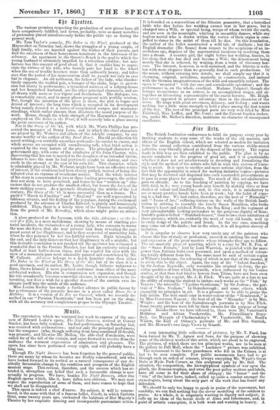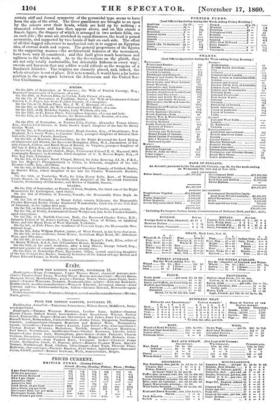/int irts.
The British Institution endeavours to fulfil its purpose every year by inviting students to copy some of the works of the old masters, and others of the English school, which are selected as models for imitation from the annual collection contributed from the various richly-stored galleries, very liberally placed at the disposal of the society. The copies made in this way are then exhibited to the public. The plan is by no means conducive to the progress of good art, and it is questionable whether it does not act mischievously in dwarfing and formalizing the style and the method of the artists who fall in with this system of learn- ing to paint. It is open to another and more serious objection, from the fact that the opportunity is seized for making imitative copies—pictures that may be doctored and disguised into such counterfeit presentments as to pass in some places for originals. Too much of this art-adulteration goes on already. As to the teaching of painting by copying, we have little faith in it ; very young hands may benefit by making three or four studies of colour and handling ; and, in this view, it is satisfactory to see so many prenticc hands have been at work ; but the habit of copy- ing is a bad one. We had rather, therefore, see the host of " Mirandas"
and "Jeans of Arc," suffering torture on the walls of the British Insti- tution in striving to resemble the lovely Susan Hamilton, who broke Romney's heart and subdued Nelson, the Sea King ; and the regiment of very uncomfortable looking pretenders to the gorgeous dignity of Rem- brandt's golden-belted "Standard-bearer," than to two close imitations of these pictures, which are evidently the work of very old hands, well up to every dodge of the palette and brush. In the one case, something may COMO out of the daubs ; but in the other, it is all hopeless slavery of imitation.
It is singular to observe how very rarely any of the painters who choose this line of study or profession, succeed in catching the real tone and expression of the great masters whose triumphs they ape to follow.
The one masterly piece of painting, which is a copy by Mr. R. Fox, of the "Sasso Ferrate," lent by Lord Warwick, is painted with far more
power than Battista Salvi ever possessed, and upon a method of colour- ing totally different from his. The same must be said of certain copies; of Wilson's landscape, the colouring of which is not that of the master, if to attain this be the object. Again, the copy of the "Infant Bacchus," by Sir Joshua Reynolds, only resembles the original in form, the pe- culiar qualities of tone which Reynolds, when influenced by his Venice studies, at that time had tried to borrow from Titian, have not been even
thought of by the copyist, Mr. J. B. Flick. We are quite at a loss to see the utility of setting the student to imitate such works as the "Fish," by
Teniers ; the miserable " Ugolino Gentleman," by Sir Joshua ; the por- trait of "Mrs. Graham," by Gainsborough ; and some others, which exemplify no principles in art. It is a pleasure to be able to praise the lady artists. The best small copy in water-colour of the "Rembrandt," is by Miss Constance Nugent ; the best of all the " Mirandas" is by Mrs. Wright ; and the best of the Gainaborough portraits is by Mrs. Flick. Sonic twenty pictures were left by their owners for the purpose of being copied. Besides those we have referred to, there were Mr. Vansittart's Hobbima and Adrian Vandervelde, Mr. Fitxwilliam's Buys- dad, the Marquis of Cholmondeley's W. Vandervelde, Mr. Bond's Wilson, the Earl of Orkney's portraits of Mr. and Mrs. Garrick, and Mr. Howard's two large Views by Guardi.
A very interesting little collection of pictures, by Mr. T. Faed, has been formed by Mr. T. Agnew and Sons, for the purpose of showing some of the choicest works of this artist, which are about to be engraved. The pictures, of which there are ten principal works, are to be seen at the gallery in Pall Mall, where the " Lucknow " picture was exhibited. The monument to the brave guardsmen who fell in the Crimea is at last to be seen complete. Few public monuments have had to go through such an ordeal of censure, always excepting Mr. Wyatt's Great Duke at Hyde Park Corner, as this sculptural pile by Mr. Bell. The situation, the composition, the hieroglyphical symbols of war upon the plinth, the Russian trophies, and even the poor paltry mottoes and labels, have all come in for their share of obloquy ; the " honor " and the
tria" of the latter have, indeed, called up quite a combat amongst the etymologists, being about the only part of the work that has found any defenders.
We should be only too happy to speak in praise of the monument, but candidly, we can find nothing but the clever modelling of the soldiers to praise. As a whole, it is singularly wanting in dignity and subject; it calls up no ideas of the heroic deeds at Alma and Inkermann, and, In point of artistic conception, it is both weak and wanting in beauty. A certain stiff and formal symmetry of the pyramidal type seems to have been the aim of the artist. The three guardsmen are brought to an apes by the colours over their heads, which are held up by nothing ; a truncated column and base then appear above, and on this stands a female figure, the drapery of which is arranged in two archaic fold'', one on each side ; the arms are stretched in equal distances, the head is poised accurately, and supported by two bands of hair en each side. The effect of all this dogged adherence to mechanical rule is to suggest an Egyptian idea of eternal death and repose. The general proportions of the figures to the supporting masses—the architectural features of the monument, have been very ill considered ; and this fault gives much heaviness and ugliness to the whole work. As to the decorations on the plinth, they are not only totally inadmissible, but detestably hideous in every way ; swords and bayonets that any soldier would ridicule as the weapons of a Sandwich Islander. The trophies are clumsily placed, and, indeed, the whole structure is out of place. If it is to remain, it would have a far better position in the open space between the Athenaeum and the United Ser- vice Clubhouses.



























 Previous page
Previous page